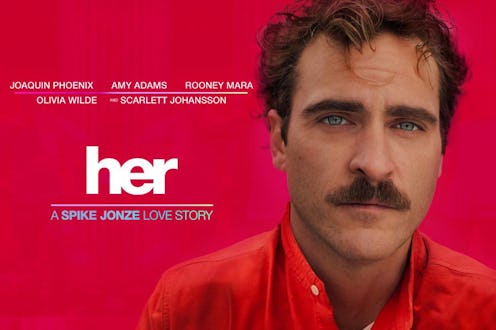Entertainment
'Her' is Closer to Reality Than You Think

For some people, Spike Jonze's Oscar-contender, Her, wasn't so much a love story as it was a look into the future of our world. Especially to Futurist (Yes, that's a real thing: I took a class on it in college) and Scientist Ray Kurzwell. According to his guesstimations and general knowhow, he not only believes the future that we see in Her is not only plausible, but likely — as do other writers — it doesn't go far enough regarding what we should expect. Hoo boy.
Kurzwell, who enjoyed the film, believes that Her "is a breakthrough concept in cinematic futurism" in the same was as The Matrix, meaning it paints "a realistic vision that virtual reality will ultimately be as real as, well, real reality." Which isn't to say that we'll all be riding along with our own operating systems, falling in love, in the future, but rather our daily lives will be enhanced by the knowledge of knowing something through someone else (in this instance an artificial intelligence)'s reality.
"It does portray a somewhat futuristic world in which the leap to human-level AIs is not so implausible. ... With emerging eye-mounted displays that project images onto the wearer’s retinas and also look out at the world, we will indeed soon be able to do exactly that," Kurzwell stated.
He even believes that the film doesn't go far enough in depiction the weird and wild technologically enhanced future. "When we send nanobots into the brain — a circa-2030s scenario by my timeline — we will be able to [experience another's perspective] with all of the senses, and even intercept other people’s emotional responses."
But his is a tale that also believes the film's limitations are in its inability to see how the rest of the world will resultingly evolve as well. Especially when it comes to experiencing the AI in real life. You know: like with a body and stuff. "There are also methods to provide the tactile sense that goes along with a virtual body. These will soon be feasible, and will certainly be completely convincing by the time an AI of the level of Samantha is feasible."
Just how soon? Less than 10 years, gulp. "I would place some of the elements in Jonze’s depiction at around 2020, give or take a couple of years, such as the diffident and insulting videogame character he interacts with, and the pin-sized cameras that one can place like a freckle on one’s face." In-house insult generator: coming soon!
As for the human-esque AI, we'll have to wait a little longer. But not too long, all things considered. "Samantha herself I would place at 2029, when the leap to human-level AI would be reasonably believable."
But when it comes to the main tension of the film — Samanatha's lack of a body versus Theodore's heart, legs, and other limbs — Kurzwell believes there is "a tactile virtual reality system that uses a physical intermediary that neither party directly experiences" that would make up for any body/non-body issues. "It would be technically trivial in the future to provide her a virtual visual presence to match her virtual auditory presence, using, lens-mounted displays, for example, that display images onto Theodore’s retinas." So, basically, you'd be connected to and experience the results of their touch, but not the touch itself. Sort of like...a ghost?
Still, if that ghastly interpretation of the future isn't for you, Kurzwell believes there is another option using those ominous-sounding nanobots. "When we have nanobots with wireless communication that go into the brain, they will be able to provide all of the senses, including the tactile sense."
Still, there are some aspects of the film that DO feel unrealistic to the futurist. Namely: Samantha's rapidfire progression:
From a technical, rather than cinematic, perspective, this evolution is much faster than will be realistic. If human-level AI is feasible around 2029, it will, according to my law of accelerating returns, be roughly doubling in capability each year. We are not provided with an exact timeline in the movie but the action seems to take place within about a year or less, yet Samantha appears to be progressing much faster than that.
At the end of the movie, she talks poetically about how something is happening to her, and there are "infinite spaces between the words," implying that she has evolved to a vast degree. For this level of advancement to take place in such a short period of time is unrealistic, at least according to my timeline.
For those contemplating a Luddite existence after all of that, Kurzwell offers a bit of solace that it won't all be computerized brain bugs and the blurring of virtual and actual reality. Instead he tends to believe that people's outlooks will evolve right alongside technology. "In my view, biological humans will not be outpaced by the AIs because they (we) will enhance themselves (ourselves) with AI. It will not be us versus the machines (whether the machines are enemies or lovers), but rather, we will enhance our own capacity by merging with our intelligent creations." And while I'm not sure I want to merge with my smartphone anytime soon, I'm sure there are plenty of people out there inspired by that outlook on the future.
Image: Annapurna Pictures